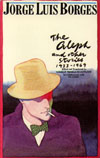-

The Aleph and Other Stories, Jorge Luis Borges “The Aleph”–Like most of his stories, this one is brief but packs a lot of information into its short length. (For those who don’t read outside of SF, imagine a J.G. Ballard condensed novel with more connections and a higher sense of the fantastic. Hmm, that was a worthless description. It is hard to find a match for Borges in the genre, because he was always succinct, and could never have survived in the dog-eat-dog world of pay by word.) The gimmick is simple–the aleph is to space what eternity is to time–but the method by which the author discovers it is unusual. I like Borges because his approach to a fantastic concept is unlike any found in the genre. Genre writing seems to emphasize the gimmick, in mainstream writing it is simply one part of the landscape against which the characters are placed. Only in Borges do all elements seem equal, similar in concept to his own aleph, to return in a style similar to Borges himself.
- “Streetcorner Man”–A first-person tale of one night in the barrio, when the ones who talk big get their comeuppance by the quiet ones. OK, but I like my stories to have a little something more.
- “The Approach to aI-Mu’tasim”–A review of a fictional book which reads, again, like a condensed novel, only in this case it truly is one. The literary device is ingenious, allowing Borges to comment on literary criticism at the same time he is creating literature.
- “The Circular Ruins”–One of Borges’ favorite subjects is the concept of infinity, another is creation. Here he bends the two together in a story that is also a metaphor for the process of setting and achieving goals.
- “Death and the Compass”–A logic problem to a mystery story, almost like Edgar Allen Poe. Poe, though, would have stretched it out to twice its length.
- “The Life of Tadeo Isidoro Cruz (1829-1874)”–I did not quite follow this one. At one point I thought that maybe Cruz was going to be killing his own father, but instead he goes to the aid of himself?
- “The Two Kings and Their Two Labyrinths”–A fable, or a sermon, that addresses what is a labyrinth. Highly appropriate subject for a Borges collection.
- “The Dead Man”–A gaucho story. Think of it as a Louis L’amour story with Argentines and Brazilians instead of Mexicans and Texans. Okay, but it’s still a western at heart.
- “The Other Death”–This is what I look for in Borges: a fantastical study of memory and history, reality and dream. Pedro did not act like a hero in the battle… or did he?
- “Ibn Hakkan al-Bokhari, Dead in His Labyrinth”–Another great story of mazes and mystery. Borges has an unusual way of framing his tales, usually with an objective third person narrator, that shortens the stories tremendously. I guess he did not get paid by the word.
- “The Man On the Threshold”–Another mystery, but not quite as fantastic as the others. Some Of these stories are morality or revenge plays, that do not require much speculation.
- “The Challenge”–A rehash of some of the gaucho themes, certainly my last favorite of his tropes. What I find interesting is the references to other stories flirt makes this seem like a reference article instead of a story.
- “The Captive”–A short short about a boy captured as a young child by natives. Borges here formulates a question about the nature of memory.
- “Borges and Myself”–Here, as in “Isidore Cruz” above, Borges talks about the nature of identity. When you look at how others perceive you and realize that that is not how you perceive yourself is a crisis of identity (as in here), or how people might perceive a younger version of you. I often look at my current life and wonder. There is no way that Glen circa. 1980 could have ever dreamed of becoming the Glen of 1998. Thoughts and hopes and goals are all so mutable. The funny thing is that I will reread these words 10 or more years from now and be struck by the same strangeness.
- “The Maker”–A discussion of what it means to go blind, nominally about Homer, but also about Borges’ own condition. I had not realized that Borges had gone blind before his death.
- “The Intruder”–Borges says that his mother, who he dictated this story to, hated it, and I can see why. It’s not something I would recommend to any woman, as it is quite misogynstic. However, it is an incredible story, and a fairly straightforward one for Borges, about friendship and brotherhood.
- “The Immortals”–A science fiction tale, strangely incongruous here. Well done, but it seems much more dated than almost everything else in this collection (stories from 1933 to 1969).
- “The Meeting”–Clever little tale about people and weapons. Almost a trick story, because the title refers to something other than what you expect.
- “Pedro Salvadores”–Short short about dictatorships and living “underground” (actually, both literally and figuratively). Borges had a real knack for the short short, never an easy thing to write.
- “Rosendo’s Tale”–To come almost entirely full circle, this tale is a sequel or antidote to the second story, “Streetcorner Man.” The gaucho here is more realistic, not so macho, and I find myself appreciating this more because of having seen the Hemingway-ish earlier story.
Finally, there is an autobiographical essay at the end, for those of us who wonder how Borges evolved (as Borges himself does in “Borges and Myself”). This collection is an excellent introduction to Borges, and clearly shows how he revolutionized the short story and became the pater familias of a new genre classification.
[Finished 26 February 1998]
